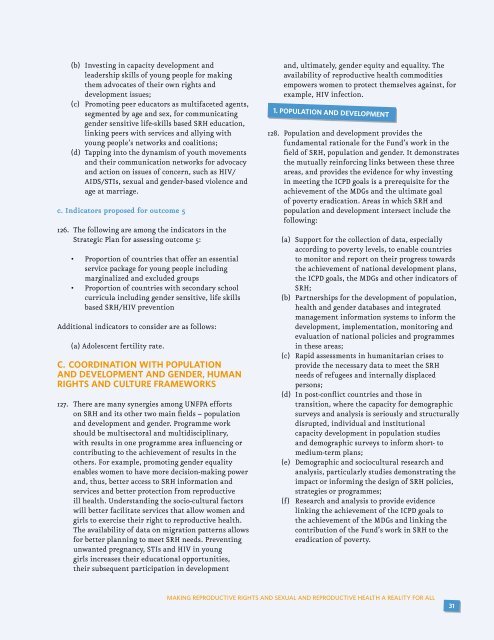Sexual and Reproductive Health Framework - UNFPA
Sexual and Reproductive Health Framework - UNFPA
Sexual and Reproductive Health Framework - UNFPA
Create successful ePaper yourself
Turn your PDF publications into a flip-book with our unique Google optimized e-Paper software.
(b) Investing in capacity development <strong>and</strong>leadership skills of young people for makingthem advocates of their own rights <strong>and</strong>development issues;(c) Promoting peer educators as multifaceted agents,segmented by age <strong>and</strong> sex, for communicatinggender sensitive life-skills based SRH education,linking peers with services <strong>and</strong> allying withyoung people’s networks <strong>and</strong> coalitions;(d) Tapping into the dynamism of youth movements<strong>and</strong> their communication networks for advocacy<strong>and</strong> action on issues of concern, such as HIV/AIDS/STIs, sexual <strong>and</strong> gender-based violence <strong>and</strong>age at marriage.c. Indicators proposed for outcome 5126. The following are among the indicators in theStrategic Plan for assessing outcome 5:• Proportion of countries that offer an essentialservice package for young people includingmarginalized <strong>and</strong> excluded groups• Proportion of countries with secondary schoolcurricula including gender sensitive, life skillsbased SRH/HIV preventionAdditional indicators to consider are as follows:(a) Adolescent fertility rate.C. Coordination with Population<strong>and</strong> Development <strong>and</strong> Gender, HumanRights <strong>and</strong> Culture <strong>Framework</strong>s127. There are many synergies among <strong>UNFPA</strong> effortson SRH <strong>and</strong> its other two main fields – population<strong>and</strong> development <strong>and</strong> gender. Programme workshould be multisectoral <strong>and</strong> multidisciplinary,with results in one programme area influencing orcontributing to the achievement of results in theothers. For example, promoting gender equalityenables women to have more decision-making power<strong>and</strong>, thus, better access to SRH information <strong>and</strong>services <strong>and</strong> better protection from reproductiveill health. Underst<strong>and</strong>ing the socio-cultural factorswill better facilitate services that allow women <strong>and</strong>girls to exercise their right to reproductive health.The availability of data on migration patterns allowsfor better planning to meet SRH needs. Preventingunwanted pregnancy, STIs <strong>and</strong> HIV in younggirls increases their educational opportunities,their subsequent participation in development<strong>and</strong>, ultimately, gender equity <strong>and</strong> equality. Theavailability of reproductive health commoditiesempowers women to protect themselves against, forexample, HIV infection.1. population <strong>and</strong> development128. Population <strong>and</strong> development provides thefundamental rationale for the Fund’s work in thefield of SRH, population <strong>and</strong> gender. It demonstratesthe mutually reinforcing links between these threeareas, <strong>and</strong> provides the evidence for why investingin meeting the ICPD goals is a prerequisite for theachievement of the MDGs <strong>and</strong> the ultimate goalof poverty eradication. Areas in which SRH <strong>and</strong>population <strong>and</strong> development intersect include thefollowing:(a) Support for the collection of data, especiallyaccording to poverty levels, to enable countriesto monitor <strong>and</strong> report on their progress towardsthe achievement of national development plans,the ICPD goals, the MDGs <strong>and</strong> other indicators ofSRH;(b) Partnerships for the development of population,health <strong>and</strong> gender databases <strong>and</strong> integratedmanagement information systems to inform thedevelopment, implementation, monitoring <strong>and</strong>evaluation of national policies <strong>and</strong> programmesin these areas;(c) Rapid assessments in humanitarian crises toprovide the necessary data to meet the SRHneeds of refugees <strong>and</strong> internally displacedpersons;(d) In post-conflict countries <strong>and</strong> those intransition, where the capacity for demographicsurveys <strong>and</strong> analysis is seriously <strong>and</strong> structurallydisrupted, individual <strong>and</strong> institutionalcapacity development in population studies<strong>and</strong> demographic surveys to inform short- tomedium-term plans;(e) Demographic <strong>and</strong> sociocultural research <strong>and</strong>analysis, particularly studies demonstrating theimpact or informing the design of SRH policies,strategies or programmes;(f) Research <strong>and</strong> analysis to provide evidencelinking the achievement of the ICPD goals tothe achievement of the MDGs <strong>and</strong> linking thecontribution of the Fund’s work in SRH to theeradication of poverty.MAKING REPRODUCTIVE RIGHTS AND SEXUAL AND REPRODUCTIVE HEALTH A REALITY FOR ALL31
















